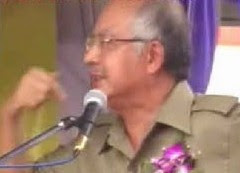Last Friday, William Dudley, the president of the Federal Reserve Bank of New York delivered a long speech on “Lessons From the Crisis” in the Center of Economic Policy Studies Symposium at Princeton University. I don’t suppose you could get any more serious than that in terms of authority and setting, even though the speaker felt compelled to issue a disclaimer: “As always, my remarks reflect my own views and opinions and not necessarily those of the Federal Reserve System.” It is astounding how no one dares to speak freely, even when the subject is a non-political, technical one and the speaker is the president of the New York Fed.
My aim is not to offer a blow-by-blow critique of the
speech. What I want to focus on, rather, is Dudley’s perspective, the way he sees things. I wrote about this seeing-things-through-the-eye-of-finance-capital in
here and
here. So the focus is not on Dudley. He is merely a Rumian part that adequately reflects the whole.
The technical description of markets and processes in the speech are generally accurate. But look at the circumlocution and the child-like narrative when the speaker explains the tri-party repo market.
In the case of the tri-party repo market, the stress on repo borrowers was exacerbated by the design of the underlying market infrastructure. In this market, investors provide cash each afternoon to dealers in the form of an overnight loan backed by securities collateral.
Each morning, under normal circumstances, the two clearing banks that operate tri-party repo systems permit dealers to return the cash to their investors and to retake possession of their securities portfolios by overdrawing their accounts at the clearing banks. During the day, the clearing banks finance the dealers’ securities inventories.
Usually, this arrangement works well. However, when a securities dealer becomes troubled or is perceived to be troubled, the tri-party repo market can become unstable. In particular, if there is a material risk that a dealer could default during the day, the clearing bank may not want to return the cash to the tri-party investors in the morning because the bank does not want to risk being stuck with a very large collateralized exposure that could run into the hundreds of billions of dollars. Overnight investors, in turn, don’t want to be stuck with the collateral. So to avoid such an outcome, they may decide not to invest in the first place. These self-protective reactions on the part of the clearing banks and the investors can cause the tri-party funding mechanism to rapidly unravel. This dynamic explains the speed with which Bear Stearns lost funding as tri-party repo investors pulled away quickly.
The result was a widespread loss of confidence throughout the money market and interbank funding market. Investors became unwilling to lend even to institutions that they perceived to be solvent because of worries that others might not share the same opinion. Rollover risk—the risk that an investor’s funds might not be repaid in a timely way—became extremely high.
These words are simultaneously convoluted and simplistic. When the speaker says that in the tri-party market “investors provide cash each afternoon to dealers in the form of an overnight loan backed by securities collateral”, it is as if a 5th-grader is explaining the market. And he has the order wrong. The drivers of the tri-party repo market are not investors who provide cash but the
broker dealers who seek money to buy an asset that they themselves could not otherwise afford. If you miss this point, you will not understand the tri-party repo market.
Dudley’s language reflects his thought process, the ways he see things. But the language is not only a passive reflector. It has an active, pernicious side as well: It hinders thinking by creating the impression that something new was told and learned while in fact nothing of the sort happened. So the real cause remains unexplored. Look at this explanation of the crisis:
At its most fundamental level, this crisis was caused by the rapid growth of the so-called shadow banking system over the past few decades and its remarkable collapse over the past two years.
But why was there a remarkable growth of shadow banking? Why did it collapse? Mr. Dudley is giving as the explanation of the crisis the very things that he is called upon to explain.
With such muddled thinking, his “framework” to fix the problem naturally degenerates into a discussion of the “psychology” of lender and borrowers, as in this gem:
This second cause of liquidity runs—the risk of untimely repayment—is significant because it means that expectations about the behavior of others, or their “psychology”, can be important. This is a classic coordination problem. Even if a particular lender judges a firm to be solvent, it might decide not to lend to that firm for fear that others might not share the same assessment.
This is the nonsense that he must have heard from some CEO or one his minions as the
cause of the crisis.
I wrote about the role of the tri-party repo market in fermenting the crisis
here and
here. Read them to see why I emphasize, and mean by, the perspective, the “angle of vision on reality”; it liberates the language and allows for imparting knowledge.
On the larger question of the
cause of crisis, I have already
pointed out that only two issues matter: the structure of the financial system which
develops naturally and could be said to be
imposed onto the system, and the fall in the value of the securities due to the transformation of values to prices. Most of this blog has been about the first issue. The question of transformation I will take up in Vols. 4 and 5 of Speculative Capital.














